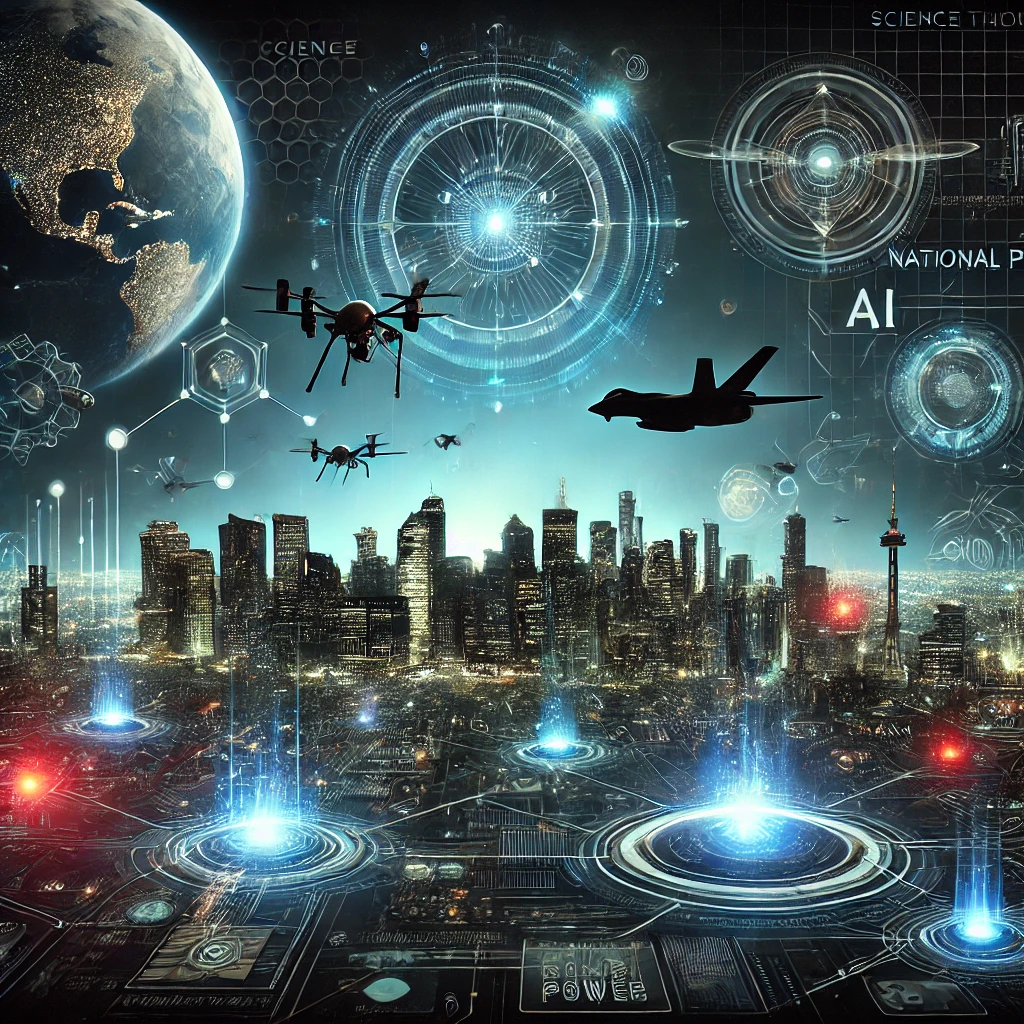Science and technology have always been central to the rise and dominance of nations. From military superiority to economic progress, from healthcare advancements to energy security, the role of scientific progress in determining a nation’s power is undeniable. In the 21st century, nations that prioritize technological advancements lead in global influence, economic strength, and national security.
This article delves into the critical areas where science and technology enhance national power, with examples from leading nations.
1. Economic Growth and Industrial Power
Science and technology serve as the backbone of a strong economy. Technological advancements drive industrial production, increase efficiency, and open new markets.
Example: China’s Technological Rise
China’s rapid economic growth is largely due to its investment in science and technology. The country has become a global leader in artificial intelligence (AI), 5G technology, and electric vehicles. Its “Made in China 2025” strategy aims to dominate high-tech industries like robotics, aerospace, and pharmaceuticals.
Similarly, Germany’s focus on Industry 4.0—which integrates automation, data exchange, and AI into manufacturing—has helped maintain its industrial supremacy.
Key Impact Areas:
- Automation in industries increases production efficiency.
- AI and robotics reduce labor costs and enhance precision.
- Digital technology promotes e-commerce and boosts international trade.
2. Military Strength and Defense Capabilities
The role of science and technology in military advancements is one of the most direct ways to enhance national power. Defense innovations ensure a country can protect itself and maintain geopolitical influence.
Example: The United States’ Military Dominance
The U.S. has maintained its global military power through continuous investment in defense technology. It has pioneered stealth aircraft (F-22 Raptor), hypersonic missiles, and autonomous drones. The U.S. also leads in cybersecurity, satellite defense, and space-based warfare capabilities.
Other Examples:
- India’s Agni-V missile: Enhances strategic deterrence with its intercontinental ballistic missile capabilities.
- Israel’s Iron Dome: Advanced missile defense system that protects against aerial threats.
- Russia’s Hypersonic Weapons: Enhancing its military power through cutting-edge missile technology.
Key Impact Areas:
- High-tech weapons provide a strategic edge in conflicts.
- Cybersecurity prevents hacking and digital warfare threats.
- Space technology strengthens surveillance and defense.
3. Energy Security and Sustainable Development
A nation’s power is closely linked to its energy security. Countries that harness renewable energy and nuclear power reduce their dependence on foreign energy sources and increase self-sufficiency.
Example: France’s Nuclear Energy Leadership
France generates around 70% of its electricity from nuclear power, ensuring energy independence. This reduces reliance on fossil fuels and strengthens its industrial sector.
China’s Renewable Energy Expansion
China has invested massively in solar and wind energy, leading global production. By doing so, it has reduced dependence on imported oil and gas while setting the stage for becoming a global leader in green energy.
Key Impact Areas:
- Renewable energy enhances economic stability.
- Reduces vulnerability to global oil and gas price fluctuations.
- Provides clean energy, improving environmental conditions.
4. Space Exploration and Strategic Advantage
Space technology contributes to national power through satellite communication, space exploration, and military applications.
Example: The Space Race Between the U.S., China, and India
- NASA’s Mars Rover and Artemis Moon Mission: The U.S. is leading human exploration beyond Earth.
- China’s Lunar Missions: China has landed rovers on the Moon and Mars, showcasing its growing space ambitions.
- India’s Chandrayaan and Gaganyaan Missions: India’s space agency ISRO is strengthening its position in space technology with successful lunar and interplanetary missions.
Key Impact Areas:
- Satellites provide critical intelligence and military communication.
- Space technology helps in global positioning and weather forecasting.
- Prestige and global influence are enhanced through successful missions.
5. Healthcare and Biotechnology
A country with advanced healthcare systems ensures a healthier population, leading to economic productivity and national stability.
Example: COVID-19 Vaccine Development
The race for COVID-19 vaccines showcased how scientific innovation determines global leadership:
- U.S. (Pfizer, Moderna): Rapid development of mRNA vaccines.
- India (Covaxin, Covishield): Large-scale vaccine production and export to developing nations.
- Russia (Sputnik V): Leveraging biotechnology for soft power diplomacy.
Key Impact Areas:
- Biotechnological advancements improve healthcare infrastructure.
- Prevents economic losses due to pandemics.
- Enhances a nation’s global influence through medical aid and vaccine diplomacy.
6. Digital Economy and Artificial Intelligence
The future of national power depends on AI, machine learning, and digital transformation.
Example: AI Race Between the U.S. and China
- The U.S. dominates AI research and development with companies like Google, Microsoft, and OpenAI.
- China has heavily invested in AI, facial recognition, and smart city technologies, with companies like Alibaba and Baidu leading innovation.
Key Impact Areas:
- AI-driven automation increases industrial output.
- Data analytics improve governance and security.
- Cyber technology strengthens defense mechanisms.
7. Agriculture and Food Security
Scientific advancements in agriculture ensure food security, which is essential for national stability.
Example: India’s Green Revolution
In the 1960s, India transformed from a food-deficient country to a global food producer through scientific innovations like high-yield crop varieties and modern irrigation techniques.
Key Impact Areas:
- Genetically modified crops increase food production.
- Smart irrigation conserves water and boosts agricultural output.
- Biotechnology enhances resistance to pests and diseases.
8. Education and Human Capital Development
A scientifically literate population drives innovation and economic growth.
Example: South Korea’s Education-Driven Technological Rise
South Korea’s investment in STEM (Science, Technology, Engineering, and Mathematics) education has turned it into a global tech hub, home to companies like Samsung and LG.
Key Impact Areas:
- Skilled workforce enhances technological innovation.
- Research institutions contribute to scientific discoveries.
- Encourages entrepreneurship and economic growth.
9. Infrastructure and Smart Cities
A country with modern infrastructure gains economic and strategic advantages.
Example: Japan’s Smart Cities and High-Speed Rail
Japan’s bullet trains and smart city initiatives have made it a leader in urban planning and transportation technology.
Key Impact Areas:
- Efficient transportation boosts economic activities.
- Smart cities improve living standards and sustainability.
- Digital infrastructure enhances cybersecurity and communication.
10. Soft Power and Technological Diplomacy
Countries that lead in science and technology gain influence through global cooperation.
Example: European Union’s Climate Leadership
The EU promotes green technology and environmental policies worldwide, positioning itself as a global leader in sustainable development.
Key Impact Areas:
- Technological collaboration strengthens alliances.
- Scientific innovations improve diplomatic relations.
- A nation’s influence grows through technology exports and partnerships.
Conclusion
Science and technology are not just tools for national progress; they are fundamental to a country’s global standing. The nations that invest in research, technological advancements, and innovation gain economic superiority, military strength, and diplomatic influence.
From China’s industrial rise to the U.S.’s military dominance, from India’s space achievements to Germany’s renewable energy leadership—scientific progress remains the foundation of national power in the modern world.
A country that prioritizes science and technology ensures long-term stability, growth, and global leadership in the 21st century.




